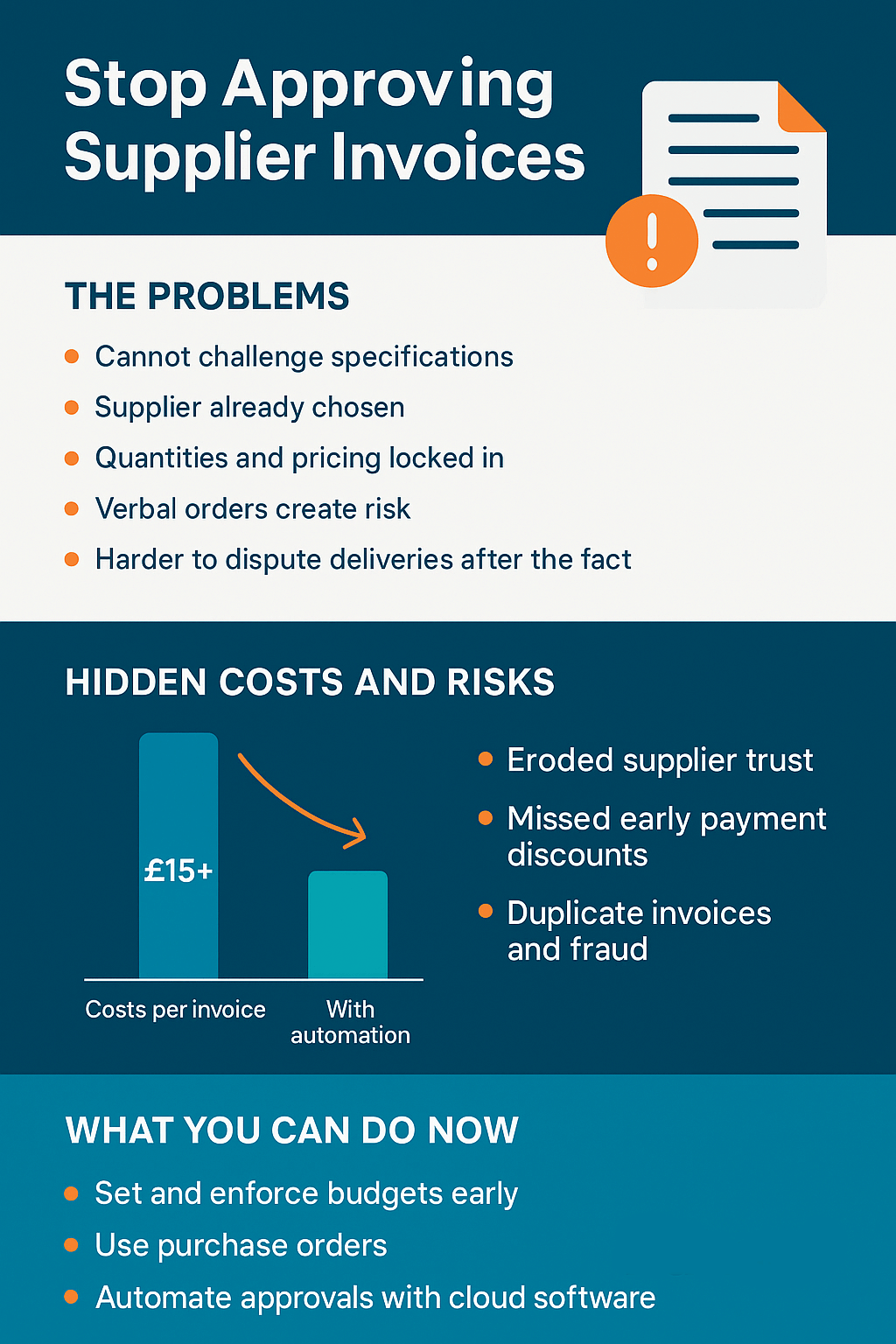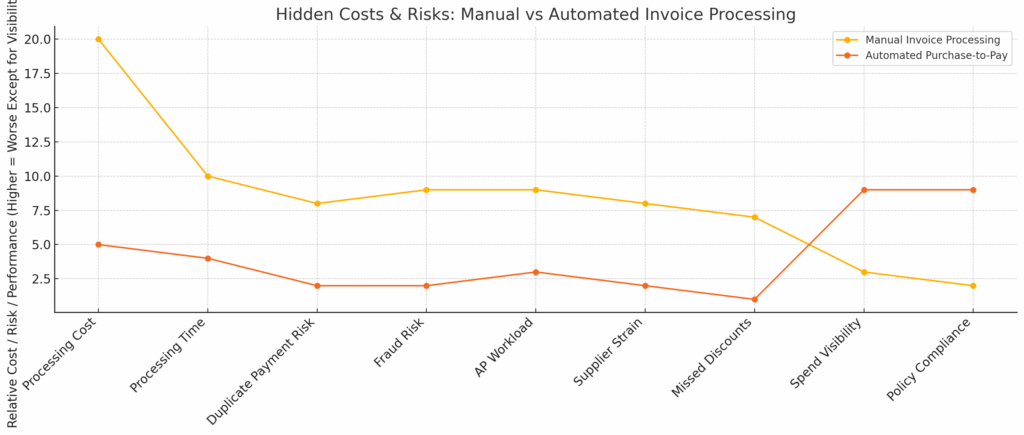When a supplier sends an invoice, they’ve already delivered the goods or services you requested. At that point, they expect to be paid — promptly and without dispute. If you’re still checking invoices manually at the accounts payable (AP) stage, your process is broken.
Table of Contents
Why Waiting Until Invoice Receipt Is Too Late
Waiting until the supplier invoice arrives creates unnecessary risks and inefficiencies:
1. Specification Cannot Be Challenged
By the time the invoice arrives, the requisitioner has already decided what to buy. It’s too late to challenge specifications at this stage.
2. Supplier Selection Is Already Made
The supplier has been chosen, often based on factors like price, availability, and service. Trying to question the supplier choice at invoice stage is both reactive and ineffective.
3. Quantities and Pricing Are Locked In
If the buyer ordered stock in bulk or took advantage of special pricing, it’s not possible to renegotiate once the invoice has been issued.
4. Verbal Orders Create Risk
Over 80% of businesses still place orders via email or phone source: Ardent Partners. Suppliers are increasingly wary of customers who don’t use formal purchase orders (POs), as it heightens their risk of delayed or non-payment.
5. It’s Harder to Dispute Deliveries After the Fact
If goods or services don’t meet expectations, it’s easier to dispute them at the point of delivery — not once the invoice is in the AP queue. Without a PO or goods receipt, disputes become subjective and contentious.
The Business Impact of Broken Invoice Processes

Eroded Supplier Trust and Higher Costs
High-quality suppliers might:
Build higher costs into their pricing.
Stop offering preferential terms.
Walk away from unreliable customers.
Hidden Costs in the AP Process

Late payments can lead to:
Missed early payment discounts.
Late payment penalties.
Extra admin time for AP teams chasing down missing approvals, budget checks, and paperwork.
In fact, research by the Institute of Finance & Management (IOFM) suggests that the cost of manually processing a single invoice can exceed $15, which can be more than the invoice itself for low-value purchases (source: IOFM).
| Factor | Manual Process (Invoice Approval at AP Stage) | Automated Process (Purchase-to-Pay Automation) | Data Source / Notes |
|---|---|---|---|
| **Average cost per invoice** | \$15–\$20 | \$3–\$5 | [IOFM](https://www.iofm.com), [Ardent Partners](https://ardentpartners.com/) |
| **Processing time per invoice** | 10+ days | 3–5 days | [Ardent Partners](https://ardentpartners.com/) |
| **Risk of duplicate payments** | High | Low | Industry data from [IOFM](https://www.iofm.com) |
| **Risk of over-payments/fraud** | High (manual checks prone to error) | Low (system controls in place) | [IOFM](https://www.iofm.com) |
| **Accounts Payable workload** | High (manual chasing, approvals, data entry) | Low (automated workflows, self-service PO) | Internal estimates from Zahara customers |
| **Supplier relationships** | Strained (delays, disputes, late payments) | Improved (faster, predictable payments) | [Pay.uk report](https://www.pay.uk) |
| **Missed early payment discounts** | Frequent | Rare | [IOFM](https://www.iofm.com) |
| **Visibility of spend against budget** | Low (often retrospective at AP stage) | High (real-time at requisition stage) | Zahara user feedback |
| **Compliance with internal policies** | Low | High | [CIPS](https://www.cips.org) |
Common Workarounds Lead to Risk
To cope, many companies auto-approve low-value invoices and only scrutinise larger ones. This might save time, but it opens the door to:
Overpayments.
Duplicate invoices.
Fraud.
Unreconciled accounts.
There Is a Smarter Way
1. Set and Enforce Budgets Early
Empower budget holders with real-time visibility of spend against budgets. Tools like Zahara’s Budget Management make this simple, allowing users to spot anomalies at the requisition stage — not at the invoice.
2. Implement a Purchase Order Process
Introducing a purchase order system needn’t be costly or complex. Solutions like Zahara’s PO Software help teams issue POs from anywhere, ensuring all spend is pre-approved and traceable. A ‘No PO, No Pay’ policy protects suppliers and encourages compliance internally.
3. Automate Approvals with Cloud Software
Cloud-based approvals software lets businesses set up automated, multi-level workflows by department, cost centre, or category. Zahara’s Invoice Approval Software ensures purchases are reviewed at the right time by the right people, without slowing down operations.
4. Stop Approving Invoices at the AP Stage
When an invoice arrives, it should already match:
The approved PO.
The goods receipt.
The agreed pricing and terms.
Your AP team shouldn’t have to police the process. Free them up to focus on credit control, supplier relationships, and accurate financial reporting.
Final Thoughts: Make the Switch to Purchase-to-Pay Automation
Businesses that streamline purchasing and remove invoice approvals at the AP stage see fewer disputes, faster payments, and stronger supplier relationships. They also reduce the risk of fraud and avoid paying twice for the same service or product.
Take the first step. Discover how Zahara can help your team improve purchasing and stop invoice approvals.
👉 Explore Zahara’s Accounts Payable Automation Software
FAQs
Why is approving invoices manually a problem?
Manual approvals are time-consuming, error-prone, and reactive. It’s more efficient to manage approvals earlier in the process using purchase orders and automated workflows.
How does a ‘No PO, No Pay’ policy help?
It ensures all spending is pre-approved and traceable, reducing disputes, fraud, and supplier payment delays.
What is the average cost of processing a supplier invoice manually?
According to IOFM, the average cost is over $15 per invoice, which can exceed the invoice value for smaller purchases.
What are the benefits of automating purchase approvals?
Automation speeds up purchasing, reduces admin for AP teams, and provides a clear audit trail for every transaction.
How can Zahara help?
Zahara provides cloud-based software for purchase orders, approvals, budget control, and supplier payments — all designed to stop invoice approvals at the AP stage.
